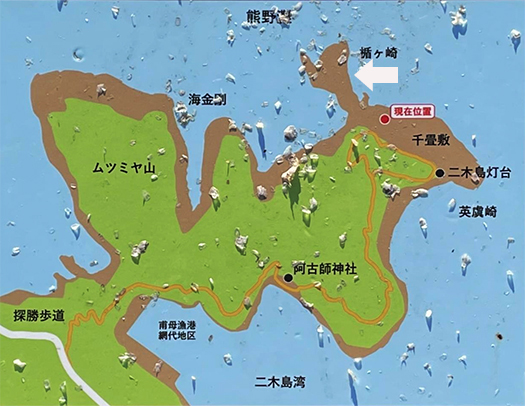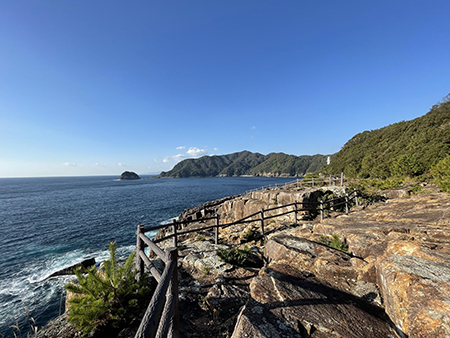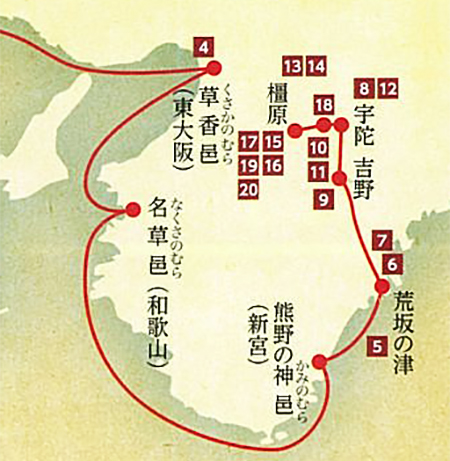


途中でシカさんと出会って、ゾッコンにさせられた(笑)この楯ヶ崎行き。どんなイキモノもその動作表情には「神がかった」ものがある。自然の摂理に沿ったイキモノとして当然。その出会いの瞬間のタイミングで「こころに残る」ということがある。たぶん恋情とも通じるものでしょうね。抗いがたい好意が芽生えるような瞬間というものがあるのでしょう。
日本文化ではなぜか奈良のシカたちがその象徴のようになっていく。神鹿。奈良春日大社の祭神、武甕槌命(タケミカヅチノミコト)は鹿島神宮(茨城県)から神鹿に乗ってきたと伝わる。鹿は神の使いとして古くから手厚く保護された。わたしは偶然、楯ヶ崎で自然のシカに出会ってしまった(笑)。だからということではないけれど、事実の背景部分で徐々に神武東征経路への「さもありなん」感プッシュ気味。
タケミカヅチノミコトは神代に国譲りの主役となり、さらに古事記ではこの神武東征上陸時にも高倉下(たかくらじ)という人物に神託を与え神武天皇に霊剣布都御魂をもたらしたとされる。
ともあれ、今次の熊野行は永くナゾと思っていた神武東征という皇統神話への探索旅。きわめて重要な上陸地に関しての実体験を得ることが中心軸です。ひとつの有力説として楯ヶ崎を海路上の目印・目途とした東征船団はその近隣の適地・良港として二木島湊に上陸したとされる。途中、神武帝の兄2人を海難で失いながら、上陸を果たしたとされるのですね。


図は橿原神宮の「神武天皇東遷の奇跡」からで、その下の港湾航空写真は三重県のHPより。図の「荒坂の津」というのが二木島と擬定されている。そこから吉野まで「八咫烏」の先導で山路を踏破していく。そして大和平定の大戦略「日を背に負って敵を制圧する」作戦展開していったという。
この大戦略は、壬申の乱でも関ヶ原でも日本史を貫いている成功戦略のようにも思える。
わたしの興味としては歴史と神話の狭隘部分についての探究心ということ。
まずは、熊野信仰というものの文化的側面を受容しつつ、日本文化のある部分を象徴している皇統神話について身体感覚を持ちたいということになるワケです。
今回までの探索では、熊野という紀伊の狭隘地域が大規模なカルデラを地形根拠にしていることが明確にわかった。そしてその異形な地形と皇統神話が強く結びついていることも体感できた。このことは、大づかみの認識として間違いがないでしょう。楯ヶ崎の柱状節理は雄弁だと思う。
そして異形の地形が日本文化に特徴的な自然崇拝・修験道などの積層があって、やがて神仏習合というように精神文化が形成されていくとき、熊野はこの精神文化の「聖地」化されていったのでしょう。それが歴史事実かどうかは別として、精神文化として色濃く堆積していったことは事実。
そのあたりの日本精神文化とはやや遠い世界標準的歴史時間を刻んできている北海道人としては、ある意味新鮮な感覚を持って体感させられているところです。
English version⬇
The Emperor Jinmu landed on Nigijima with Tategasaki as his goal? The Imperial Mythology and Kumano Journey-8]
A search for the myth surrounding Arasaka-no-tsu, the point of landing in Kumano during the Jinmu expedition to the east. As a Hokkaido resident, I would like to experience the narrow point between faith and truth. …
On the way to Tategasaki, I met Shika-san, who made me fall in love with him (laugh). Every animal has a “godlike” expression in its movement. It is natural for any creature to have a “divine” expression. The timing of the moment of encounter is what makes it “memorable. Perhaps it is the same with love. There must be a moment when an irresistible affection develops.
In Japanese culture, for some reason, the deer of Nara have become a symbol of this. The “sacred deer”. Takemikazuchi-no-mikoto, the deity of the Kasuga Grand Shrine in Nara, is said to have ridden a sacred deer from the Kashima Shrine (Ibaraki Prefecture). Deer, as the messengers of the gods, have long been heavily protected. I happened to meet a natural deer in Tategasaki (laughs). (Laughs.) Not necessarily because of that, but the background of the fact is gradually pushing the “so it goes” feeling toward the route of the Jimbu expedition.
Takemikazuchinomikoto played a leading role in the handing over of the land to the Emperor in the divine era, and according to the Kojiki, he gave an oracle to a man named Takakura-ji when he landed on the eastern coast of Japan to bring the sacred sword Futo-mikoto to Emperor Jinmu.
In any case, this next trip to Kumano is a journey of exploration into the mythology of the imperial lineage of the Jinmu expedition, which has long been a mystery to us. The central axis of this trip is to gain firsthand experience of the most important landing sites. One popular theory is that the expeditionary fleet, which had set its sights on Tategasaki, landed at Futakishima Minato as a suitable location and good port nearby. It is said that they made landfall while losing two of Emperor Jinmu’s elder brothers in maritime accidents along the way?
The figure is from “The Miracle of Emperor Jinmu’s Eastward Transition” at the Kashihara Jingu Shrine, and the harbor aerial photo below it is from Mie Prefecture’s website. The “Arasaka-no-tsu” in the figure is identified as Futakijima. From there, “Yatagarasu” led the way through the mountains to Yoshino. They then developed a grand strategy to conquer the enemy with the sun on their backs in order to pacify Yamato.
This grand strategy seems to be a successful strategy that has been followed throughout Japanese history, both in the Jinshin Rebellion and in Sekigahara.
My interest is to explore the narrow point between history and mythology.
First of all, I would like to have a physical sense of the mythology of the imperial lineage, which symbolizes a certain part of Japanese culture, while accepting the cultural aspects of the Kumano faith.
In this exploration, it has become clear that Kumano, a narrow region in Kii, is based on a large caldera. We have also experienced the strong connection between the unusual topography and the myth of the imperial lineage. There is no doubt about this as a general understanding. I think the columnar joints of Tategasaki are eloquent.
And when the oddly shaped topography was layered with nature worship, Shugendo, etc., characteristic of Japanese culture, and eventually spiritual culture was formed, as in the Shinto/Buddhist syncretism, Kumano must have been made a “sacred place” for this spiritual culture. Whether this is a historical fact or not, it is a fact that the spiritual culture has been strongly deposited in Kumano.
As a Hokkaido resident who has lived in a world-standard historical time that is somewhat distant from the Japanese spiritual culture, I am experiencing it with a fresh sensation in a certain sense.
Posted on 1月 9th, 2024 by 三木 奎吾
Filed under: 日本社会・文化研究







コメントを投稿
「※誹謗中傷や、悪意のある書き込み、営利目的などのコメントを防ぐために、投稿された全てのコメントは一時的に保留されますのでご了承ください。」
You must be logged in to post a comment.